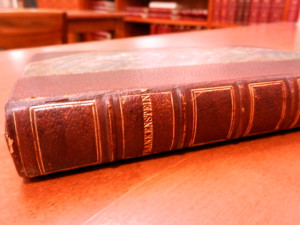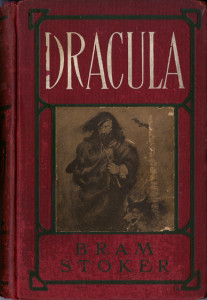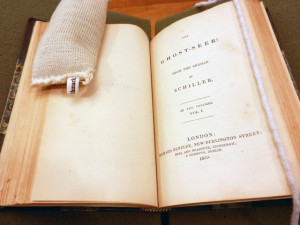
“Listen to them, the children of the night. What music they make!”
–Bram Stoker, Dracula
Boo!
Yes. It’s that time of year, again. In a couple of days ghosts and goblins and things that go bump in the night will be traipsing through our neighborhoods, prowling our streets in search of the sweet sustaining nectar of chocolate, caramel, and assorted goodies.
Looking for ways to wind yourself into the witching hour? The University of Houston Special Collections has just the thing (or two) to do the, ahem, trick.
We recently acquired a 1902 printing of the definitive vampire novel, Bram Stoker’s Dracula. While it is still in the process of being cataloged, interested students of the Victorian period can encourage their professors to bring their classes to the Evans Room to study it or students may view this iconic novel themselves in the Special Collections Reading Room. This printing features stunning cover art sure to curdle the blood. Initially published in 1897, Dracula, with its narrative of an insidious interloper threatening and tainting English society (and its women), fit the mold of the popular “invasion literature” genre taking hold in England at the turn of the century and prior to the Great War.
And while Dracula may be the definitive vampire novel, the character itself may owe a nod elsewhere.

Frankenstein or The Modern Prometheus by Mary Shelley, available for study in the Special Collections Reading Room
In the 1816 summer following the eruption of Mount Tambora, Lord Byron invited a number of writer-artist types to his Lake Geneva estate for a season of diversion. Plagued by the dreary weather found in the wake of a literal atmospheric change and volcanic winter, the friends tended to stay indoors, talking and swapping stories–the stuff of writing. Legend has it that from this peculiar summer spent in the gloom of a world without a sun, blotted out by ash, Mary Shelley, as she phrases it, “then a young girl, came to think of, and to dilate upon, so very hideous an idea,” a Modern Prometheus. We think of it today as simply Frankenstein.
However, ironically overshadowed from this summer and its lore is her husband’s work during this same period that helped give rise to another monstrosity–an elegant and aristocratic vampire that, alas, he just could not seem to make work in fiction. But, as the idea bounced around that summer, John Polidori (also present amongst these fast friends) completed it as the novella The Vampyre (Spoiler alert, the vampire is a member of elite society and a bit of a lothario. Sound familiar?). Nearly 100 years later, this character, coupled with the English xenophobia of the century’s turn gave rise to an archetype that now defines a genre, thrilling and chilling us ever since.
Halloween owes quite a bit to that one peculiar year without a summer.
Dracula and Frankenstein are both favorites this time of year and whether you prefer supernatural monsters or the darkness of the human soul, UH Special Collections has you covered. As luck would have it, in addition to the recent Dracula acquisition, we also have available for study an 1839 printing of Shelley’s labor from that bewitching summer. This edition of Frankenstein or The Modern Prometheus is printed and bound alongside Friedrich Schiller’s The Ghost-Seer, so you get two tales for the price of one with your visit!
Whether this week or any week of the year, visit us in Special Collections for timeless thrills and chills.

